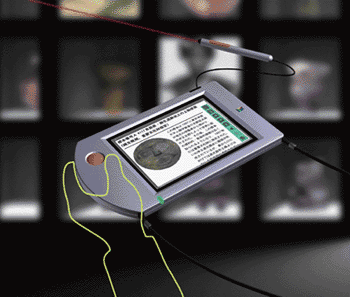
Personalized Digital Museum Assistant
− Ken Sakamura −
PDMA (Personalized Digital Museum Assistant) is a tool that uses computer technology to strengthen "exhibitions" which enable visitors to achieve more enjoyment as well as greater knowledge and excitement from museums. PDMA is a term created to encompass the meaning of a tool to enjoy the personalized digital museum by using a PDA (Personal Digital Assistant) which is the mobile terminal. A variety of formats were devised in the course of achieving the PDMA, and at the University Museum the University of Tokyo a number of formats of PDMA were researched and developed, and subjected to repeated trial testing. In principle, electronic tags are attached to exhibits, and the PDMA reads off data from the electronic tags, thereby detecting what visitors want to know about what exhibits. In response, the PDMA displays or provides a voice commentary about information related to that exhibit.

The key feature of PDMA is the ability to personalize. By setting the services required by visitors when the PDMA is lent out, a commentary that meets the needs of the individual is provided. This may include aspects such as the language used, the size of the font, the degree of specialized knowledge, and being for children, etc. With the conventional method of displaying information on panels to the side of exhibits, it was impossible to give detailed explanations due to space restrictions and ease of viewing. In addition, when people gather to see a commentary panel, an increasing number of people who go past without seeing the commentary, which results in a drop in the level of service provided to museum visitors. By having each individual carry a PDMA, it is possible to listen/view a commentary that meets one's own needs on one's own terminal at one's own pace. That is to say, each visitor is provided with a considerate guide, who provides the information that visitor wants to hear and see. Recent times have seen the implementation of relatively high-speed wireless LANs, enabling the use of high-performance mobile terminals, so by linking these terminals with databases on museum servers it is possible to provide more detailed information and abundant content. If links are created between museums, then it becomes possible to carry out comparisons over the internet with exhibits stored in other museums and their data, and there is great value in using such information not only for general museum visitors but also for purposes of research by specialists.
Furthermore, by having PDMAs not only read off electronic tags and provide a corresponding explanation, but by having the exhibit side communicate with the PDMA, it is possible to obtain information about what type of people are viewing the exhibit. This information can then be used to dynamically change the display content accordingly. Similarly, by gathering information such as what type of people came to see a particular exhibit, it is possible to use this information to plan exhibits which provide more excitement and interest to users.